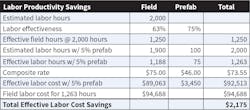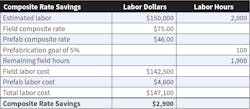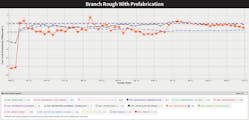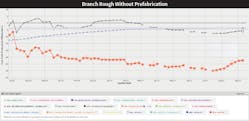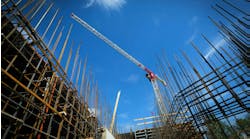Prefabrication in construction is a very broad topic. As such, it covers many different areas. Regardless of how much prefab work you are doing, where you are doing it, or who is doing it, the one common fact is that everyone struggles to see how prefab saves them money — and how much money it saves them. So, here’s a simple way to quickly recognize and measure the benefit of prefabrication on your projects. This is by no means a comprehensive measure of the benefits and cost savings; it is a simple look at two easily measured contributions to cost reduction from prefabrication.
A prefabrication environment can offer the benefits of climate control and greater production efficiencies combined with a cheaper labor rate for the lesser-skilled employees needed for more standardized work. With that in mind, having a few journeymen on site working on assemblies or painting boxes/face plates is not an ideal use of their skill and is not helping you benefit from prefabrication. Most of the benefits available from utilizing prefabrication on the project are first recognized during the planning phase of the job. Only if your planning processes account for where the work should be performed, when the work should be performed, and what skills are needed to perform the work can you benefit from increased installation productivity as well as a reduced composite rate.
How to plan for prefab
Let’s begin by comparing the productivity or effective labor spent working on assemblies in a manufacturing-based environment versus on a job site. Some of the biggest differences between the two environments are the normal job-site distractions from work going on by other trades, having to mobilize and demobilize according to the general contractor’s (GC’s) schedule, and locating/handling tools and materials. Studies have shown that field personnel typically have 63% (or five out of eight hours) of their time available for the final installation of material. The remaining time and effort is lost to handle, manipulate, and assemble components before installation. Meanwhile, similar studies have shown that work being performed by prefab in a manufacturing-based environment is far more effective, using as much as 75% of their time for the assigned production tasks. The reason behind this 20% or more gain in productivity is due to the reduction of material handling and variation of site conditions on the project, essentially the ability for managers and supervisors to manage and control the work environment.
For example, project “Mission Critical” has a labor budget of 2,000 hours. Based on the field personnel with productive installation accounting for only five of the eight available hours each day, the project will have 1,250 hours of effective labor spent on the final assembly and installation of the material. The project manager set a goal to have 5% of the work go through the company’s prefabrication department. Using the 5% prefabrication goal from the labor budget of 2,000 hours, the project manager is now designating 100 hours from the labor budget to go to the prefabrication department. The project now has 1,900 hours left in the budget, which translates to 1,188 hours of effective installation effort. The prefabrication department has an effective labor productivity of 75%. Using the 100 hours of the labor budget, the prefabrication department has 75 hours of effective labor giving the project 1,263 hours of effective labor for assembly and installation of material. The project manager, by budgeting 5% of the labor budget on the project to the prefabrication department, increased the project’s effective labor productivity by 1%. Not only did the project manager increase hours of effective labor, but this increase also came with cost savings as well. Originally, the project manager started with 1,250 hours of effective labor productivity at $75 an hour, which carried a cost of $93,750. Now the project has 1,263 hours of effective labor productivity. To have the same 1,263 hours of effective labor productivity, the project manager would have to carry an additional 2.4% in labor cost, bringing the effective labor cost to $94,688 or 1,263 hours at $75 an hour (Table 1).
Understanding a project’s composite labor rate
The second aspect of the cost savings metric of prefabrication to examine is its impact on the project’s composite labor rate. Assume that field labor for the company carries a fully loaded rate of $75 an hour, while the prefabrication department maintains a labor rate of $46 an hour. From the labor budget of 2,000 hours, the Mission Critical project has an estimated labor cost of $150,000. Using the project manager’s prefabrication goal of 5% or 100 hours from the labor budget, the project now has 1,900 field hours at $75 an hour or $142,500 in field labor. The prefabrication department’s labor budget of 100 hours at $46 an hour costs $4,600. The total labor budget on the project is now $147,100 or a savings of $2,900 from the original estimate of $150,000. In doing so, the project manager is able to spend $147,100 on labor and still maintain the original labor budget of 2,000 hours. This is because the composite labor rate on the project has been reduced by $1.45 or 1.9% to $73.55 (Table 2).
At the end of the day, because the project manager set a goal of 5% prefabrication on project Mission Critical, he was able to achieve a total cost savings of $5,075 by saving $2,175 based on the 1% increase in the effective labor productivity, and a savings of $2,900 on the 1.9% reduction of the composite rate.
The graphics highlight the productivity gains realized by prefabrication on the same labor code – branch rough. Figure 1 is from a project that had planned ahead of time and identified the work that could be done off-site by the prefabrication department. The second project did not utilize prefab on the branch rough work of the project; as a result, the productivity of the branch rough work negatively impacted the project (Fig. 2).
Phil Nimmo is vice president of business development at MCA, Inc. He can be reached at [email protected]. Jim Ford is the lead data analyst at MCA, Inc. He can be reached at [email protected].

